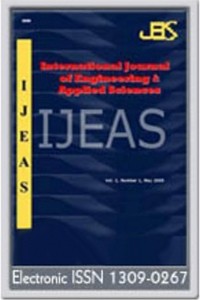PROBABILISTIC SEISMIC HAZARD MAPS FOR ADANA PROVINCE IN TURKEY
Turkey is located in a highly seismic region, where Mw > 6.5 earthquakes take place in every 10 year. According to the seismic zonation map of Turkey, approximately 42 % of the Turkish territory is located in the most seismic prone zone, known as Zone I. The other seismic zones are termed as Zone II, III and IV from the second severe to the least severe one. In this paper, we investigated the seismicity of Adana Province that is situated on four different seismic zones (i.e. Zone I to IV). Accordingly, we developed probabilistic seismic hazard maps of Adana for 475 year return period for stiff and soft site conditions. The probabilistic seismic hazard maps are presented in terms of PGA. The comparative maps indicate remarkable differences between proposed PGA values and the current design PGA values provided by the seismic zonation map and Turkish Earthquake Code
Keywords:
Probabilistic seismic hazard map, seismic hazard in Adana seismic hazard assessment, PGA hazard map,
___
- [1] Afet ve Acil Durum Yönetimi Başkanlığı, AFAD, Aylık Deprem Raporu, Haziran, 2010.
- [2] Turkish Eartquake Code, TEC. “Specification for Buildings to be built in Seismic Zones. Ankara, Turkey, Ministry of Public Works and Settlement, Government of Republic of Turkey, 2007.
- [3] Woo, G., “Kernel Estimation Methods for Seismic Hazard Area Source Modeling,” 86, 2, 353–362, 1996.
- [4] Erdik, M., Biro, Y.A., Onur, T., Şeşetyan, K., and Birgoren, G., “Assessment of earthquake hazard in Turkey and neighboring regions” Ann. di Geofis., vol. 42, no. 6, 1999.
- [5] Özgül, N. ve Kozlu, H., Kozan-Feke (Doğu Toroslar) Yöresinin Stratigrafisi ve Yapısal Konumu İle İlgili Bulgular. TPJD Bülteni, 14 (1), 1-36. 2002
- [6] Usta, D., Adana İli Jeolojik Özellikleri. MTA, Adana, pp 17, 2007. http://www.mta.gov.tr/v2.0/bolgeler/adana/bolgesel-jeoloji/jeoloji-adana.pdf, (accessed 21.01.2015)
- [7] Rojay, B., Heimann, A., and Toprak, V., “Neotectonic and volcanic characteristics of the Karasu fault zone (Anatolia, Turkey): The transition zone between the Dead Sea transform and the East Anatolian fault zone,” Geodin. Acta, 14, 197–212, 2001.
- [8] Koçyiğit, A. and Özacar, A. A., “Extensional Neotectonic Regime through the NE Edge of the Outer Isparta Angle, SW Turkey : New Field and Seismic Data,” Turkish J. Earth Sci., 12, 67–90, 2003.
- [9] Duman, T. Y., and Emre, O. The East Anatolian Fault: geometry, segmentation and jog characteristics. Geological Society, London, Special Publications, 372(1), 495–529, 2013.
- [10] Emre, Ö., Duman, T. Y., Özalp, S., Elmacı, H., Olgun, Ş and Şaroğlu F., “1:250,000 Scale Active Fault Map of Turkey”, 2013.
- [11] Global Earthquake Model, GEM. “Historical Earthquake Catalog”, 2013.
- [12] Turkelli, N., “Seismogenic zones in Eastern Turkey,” Geophys. Res. Lett., 30, 24, 8039, 2003.
- [13] Vanacore, E. A., Taymaz, T., and Saygin, E., “Moho structure of the Anatolian Plate from receiver function analysis,” Geophys. J. Int., 193, 1, 329–337, 2013.
- [14]. Kadirioglu, T. F., Kartal, R. F., Kılıç, T., Kalafat, D., Duman, T. Y., Özalp, S., Emre, Ö., “An Improved Earthquake Catalog (M≥4.0) For Turkey and Near Surrounding (1900-2012). Second European Conference on Earthquake Engineering and Seismology, İstanbul, 25-29 August, 2014.
- [15] Ulusay, R., Tuncay, E., Sonmez, H., and Gokceoglu, C., “An attenuation relationship based on Turkish strong motion data and iso-acceleration map of Turkey,” Eng. Geol., 74, 3– 4, 265–291, 2004.
- [16] Scordilis, E. M., “Empirical Global Relations Converting Ms and mb to Moment Magnitude,” J. Seismol., 10, 2, 225–236, 2006.
- [17] Akkar, S., Cagnan, Z., Yenier, E., Erdogan, O., Sandıkkaya, M. A., and Gülkan, P., “The Recently Compiled Turkish Strong-Motion Database : Preliminary Investigation for Seismological Parameters,” J. Seismol., 14, 457–479, 2010.
- [18] Gardner, J. K. and Knopoff, L., “Bulletin of the Seismological Society of America,” Bull. Seismol. Soc. Am., 64, 5, 1363–1367, 1974.
- [19] Stepp, J. C., “Analysis of Completeness of the Earthquake Sample in the Puget Sound Area and Its Effect on Statistical Estimates of Earthquake Hazard,” in Proceedings of the International Conference on Microzonation, Seattle, U.S.A, 897–910, 1972.
- [20] Nasir, A., Lenhardt, W., Hintersberger, E., and Decker, K., “Assessing the completeness of historical and instrumental earthquake data in Austria and the surrounding areas,” Austrian J. Earth Sci., 106, 1, 90–102, 2013. Eroğlu Azak, T.,
- Başlangıç: 2009
- Yayıncı: Akdeniz Üniversitesi
